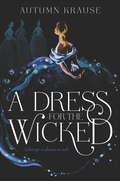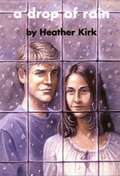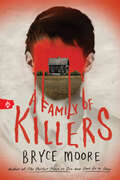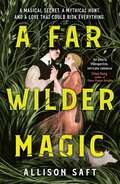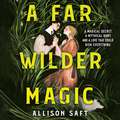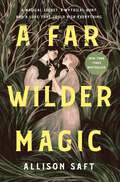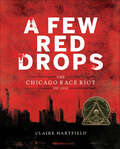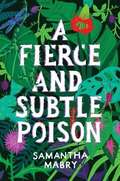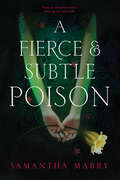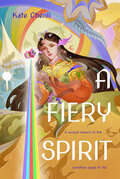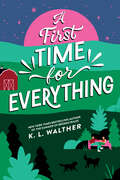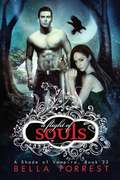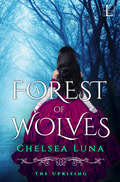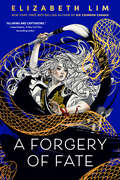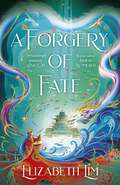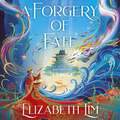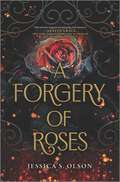- Table View
- List View
A Dream to Touch
by Anne Emery“The story of Marya Rose is the story of a challenge met, and a love that grew where no love was foreseen." A 50s era coming of age story for a young Polish girl growing up on Chicago's West side.
A Dress for the Wicked
by Autumn Krause“Set in an alternate Victorian London–like past, this blends competition and cooperation for compelling drama. A unique debut with plenty of flair.” — Booklist“Krause deftly handles the oft-belittled personal and political power of clothing, and fans of couture and fabulous fashion will enjoy the extravagant clothing and glamorous world that Emmy is determined to enter.” — Bulletin of the Center for Children’s Books“No one expects Emmaline, a girl from the country, will have anything to offer. Forced to adapt to a ruthless environment, Emmaline will surprise them — and surprise herself, too. If you binge Project Runway and gobble down YA dystopias, then A Dress For the Wicked is for you.” — Refinery 29
A Drop of Rain
by Heather KirkIn this dark and moving young adult novel, sixteen-year-old Naomi’s best friend has moved away, and Naomi herself is starting at a new high school. Curtis, the artistic guy she likes, seems to be avoiding her, making her feel alone and lonely. On top of lots of difficult homework and an awful part-time job, she also has problems at home. Her dying aunt has come to live with her family, Naomi’s mother seems to be on the verge of a breakdown, and her Polish father is absent and unsupportive. How can Naomi overcome all these negatives in her life? Over three harrowing months on the eve of the new millennium, the story emerges of a young woman finding strength and of a broken family mending. The action and circumstances of the book are laid bare in a series of diary entries, not only by Naomi, but also by her boyfriend, her mother, her mothers boyfriend, and Naomi’s employer, giving the reader a much fuller understanding of what brings Naomi and her mother to the brink of despair - and back.
A Fabulous Creature
by Zilpha Keatley SnyderFifteen-year-old James has just discovered the magnificence of nature—but can he protect it from the phoniness of the material world?When his academic-minded parents decide to forsake civilization for a wilderness summer in the Sierra Nevada mountains, James Fielding figures he&’ll be counting the minutes until it&’s over. But in the woods one day, he comes upon a magnificent deer and becomes fascinated by its majesty and beauty. Then he meets two very different girls. Thirteen-year-old Griffin Donahue is &“pure and free and beautiful.&” Diane Jarrett is a tanned, &“hot-pink-bikinied&” goddess. Griffin is at one with nature. Diane is slumming at the nearby exclusive camp, with its decadent luxury and A-list guests. When these two worlds collide, threatening the existence of the stag, James embarks on a quest to find a friend who&’s gone missing—and to save a life.This ebook features an extended biography of Zilpha Keatley Snyder.
A Face Like Glass
by Frances HardingeAn enchanting underground world hides sinister secrets in this YA fantasy from award-winning author Frances Hardinge. In the underground city of Caverna, the world’s most skilled craftspeople toil in the darkness to create delicacies beyond compare—wines that remove memories, cheeses that make you hallucinate, and perfumes that convince you to trust the wearer, even as he slits your throat. On the surface, the people of Caverna seem ordinary, except for one thing: their faces are as blank as untouched snow. Expressions must be learned, and only the famous Facesmiths can teach a person to express (or fake) joy, despair, or fear—at a steep price. Into this dark and distrustful world comes Neverfell, a girl with no memory of her past and a face so terrifying to those around her that she must wear a mask at all times. Neverfell’s expressions are as varied and dynamic as those of the most skilled Facesmiths, except hers are entirely genuine. And that makes her very dangerous indeed . . .
A Face for Picasso: Coming of Age with Crouzon Syndrome
by Ariel HenleyA Schneider Family Book Award Honor Book for Teens"Raw and unflinching . . . A must-read!" --Marieke Nijkamp, #1 New York Times-bestselling author of This Is Where It Ends"[It] cuts to the heart of our bogus ideas of beauty." –Scott Westerfeld, #1 New York Times-bestselling author of Uglies I am ugly. There's a mathematical equation to prove it.At only eight months old, identical twin sisters Ariel and Zan were diagnosed with Crouzon syndrome -- a rare condition where the bones in the head fuse prematurely. They were the first twins known to survive it.Growing up, Ariel and her sister endured numerous appearance-altering procedures. Surgeons would break the bones in their heads and faces to make room for their growing organs. While the physical aspect of their condition was painful, it was nothing compared to the emotional toll of navigating life with a facial disfigurement.Ariel explores beauty and identity in her young-adult memoir about resilience, sisterhood, and the strength it takes to put your life, and yourself, back together time and time again.
A Family of Killers
by Bryce MooreFrom the author of The Perfect Place to Die and Don't Go to Sleep comes another chilling horror that explores the eerie story of America's first serial killer family.Warren Bullock always thought he was a decent person. But lately he's been haunted by a sinister voice in his head urging him to commit unspeakable acts of violence against the people around him.And then the rumors start... There have been a string of disappearances in southeastern Kansas, and his father's friend is one of the missing travelers. When Warren's father leaves to investigate and doesn't return, Warren knows this is his chance to prove that he is stronger than his darkest impulses. As he makes his way through Kansas, he finds himself at a suspicious inn run by the Benders, a family with deeply unsettling mannerisms. They watch every move he makes, stand over him in his sleep, and the daughter seems to be able to see into both the past and future.As he delves further into the disappearances, he realizes one or all of the Benders may be responsible for all the missing people—and might be the reason his father never came home. It's up to Warren to set things right, even if that means giving into the voice he has been working so hard to ignore.
A Far Wilder Magic
by Allison SaftA MAGICAL SECRET. A MYTHICAL HUNT. AND A LOVE THAT COULD RISK EVERYTHING. In the dark, gothic town of Wickdon, Maggie Welty lives in an old creaking manor. Maggie's mother is an alchemist who has recently left town, leaving Maggie with just her bloodhound for company. But when Maggie spots a legendary ancient fox-creature on her porch, her fate is changed forever. Whoever tracks down and kills the hala in the Halfmoon Hunt will earn fame and riches - and if Maggie wins the hunt, she knows her mother will want to celebrate her. This is her chance to bring her home.But the rules state that only teams of two can join the hunt, and while Maggie is known as the best sharpshooter in town, she needs an alchemist.Enter Wes Winters. He isn't an alchemist ... yet. Fired from every apprenticeship he's landed, this is his last chance.Maggie and Wes make an unlikely team - a charismatic but troubled boy, and a girl who has endured life on the outskirts of a town that never welcomed her. But as the hunt takes over, the pair are drawn together as they uncover a darker magic that may put everything they hold dear in peril...A rich and tender YA fantasy love story. Perfect for fans of Sorcery of Thorns and Finbar Hawkins.
A Far Wilder Magic
by Allison SaftA MAGICAL SECRET. A MYTHICAL HUNT. AND A LOVE THAT COULD RISK EVERYTHING. <p><p>In the dark, gothic town of Wickdon, Maggie Welty lives in an old creaking manor. Maggie's mother is an alchemist who has recently left town, leaving Maggie with just her bloodhound for company. But when Maggie spots a legendary ancient fox-creature on her porch, her fate is changed forever. Whoever tracks down and kills the hala in the Halfmoon Hunt will earn fame and riches—and if Maggie wins the hunt, she knows her mother will want to celebrate her. This is her chance to bring her home. <p><p>But the rules state that only teams of two can join the hunt, and while Maggie is known as the best sharpshooter in town, she needs an alchemist. <p><p>Enter Wes Winters. He isn't an alchemist ... yet. Fired from every apprenticeship he's landed, this is his last chance. <p><p>Maggie and Wes make an unlikely team—a charismatic but troubled boy, and a girl who has endured life on the outskirts of a town that never welcomed her. But as the hunt takes over, the pair are drawn together as they uncover a darker magic that may put everything they hold dear in peril…. <p><p>A rich and tender YA fantasy love story. Perfect for fans of Sorcery of Thorns and Finbar Hawkins.(P) 2022 Macmillan Audio
A Far Wilder Magic
by Allison SaftAN INSTANT NEW YORK TIMES BESTSELLERAN INSTANT INDIE BESTSELLERONE OF 2022'S MOST ANTICIPATED READS: * BUZZFEED * EPIC READS * GOODREADS * THE NERD DAILY * UNITED BY POP *"An utterly transportive read, unfolding into a world of crumbling manors and ancient forests. Allison Saft crafts a deliberate, intricate romance that will have you as unmoored as the characters." —Chloe Gong, New York Times bestselling author of These Violent DelightsA romantic YA fantasy perfect for fans of Erin A. Craig and Margaret Rogerson, about two people who find themselves competing for glory—and each other's hearts—in a magical fox hunt.When Margaret Welty spots the legendary hala, the last living mythical creature, she knows the Halfmoon Hunt will soon follow. Whoever is able to kill the hala will earn fame and riches, and unlock an ancient magical secret. While Margaret is the best sharpshooter in town, only teams of two can register, and she needs an alchemist.Weston Winters isn’t an alchemist—yet. He's been fired from every apprenticeship he's landed, and his last chance hinges on Master Welty taking him in. But when Wes arrives at Welty Manor, he finds only Margaret. She begrudgingly allows him to stay, but on one condition: he must join the hunt with her.Although they make an unlikely team, they soon find themselves drawn to each other. As the hunt looms closer and tensions rise, Margaret and Wes uncover dark magic that could be the key to winning the hunt—if they survive that long.In A Far Wilder Magic, Allison Saft has written an achingly tender love story set against a deadly hunt in an atmospheric, rich fantasy world that will sweep you away."Innovative, romantic, and intoxicating. A Far Wilder Magic is a diamond of the YA fantasy genre, with a fresh and artfully layered world and extraordinary characters to match." —Amanda Foody, author of Ace of Shades
A Few Red Drops: The Chicago Race Riot of 1919
by Claire HartfieldThis mesmerizing narrative nonfiction draws on contemporary accounts as it traces the roots of an explosion that had been building for decades in race relations, politics, business, and clashes of culture.Coretta Scott King Award winner * Carter G. Woodson Book Award from the National Council for the Social StudiesOn a hot day in July 1919, five black youths went swimming in Lake Michigan, unintentionally floating close to the "white" beach. An angry white man began throwing stones at the boys, striking and killing one.Racial conflict on the beach erupted into days of urban violence that shook the city of Chicago to its foundations. A Few Red Drops is "readable, compelling history," The Horn Book wrote, adding that the book uses "meticulously chosen archival photos, documents, newspaper clippings, and quotes from multiple primary sources."Includes archival photos and prints, source notes, bibliography, and an index.
A Field Full of Horses: Read And Wonder (Fountas & Pinnell LLI Blue #Level M)
by Peter Hansard Kenneth LillyDo you love horses? <P><P>Do you love the way their noses are silky-soft but bristly too? <P><P>And the way a horse's tail slowly swishes as he rests in the shade with eyes half-shut? <P><P>Do you love to see them trot, canter, gallop, buck and rear? <P><P>Every child who has ever clambered up the back of a pony or dreamed of owning a horse will delight in A FIELD FULL OF HORSES. <P><P>Full of interesting facts about horses, this handsome book captures the very essence of horses for the very young.
A Field Guide to Narnia
by Colin DuriezFrom the Book jacket: Whether this is your first visit or you've been there many times, you'll want to bring along this handy guide to the landscape and inhabitants of Narnia. You'll learn more about the mind behind Narnia, how Narnia relates to other imaginative worlds and children's literature, the history within the stories of Narnia, and how Narnia fits into Lewis's other work. This book will help you dig deeper into the series and its implications for understanding the Christian life. "Colin Duriez . . . provides profound insight into the brilliant mind and prolific writings of C. S. Lewis. By carefully interweaving the life experiences of Lewis with an analysis of his vast body of scholarly and popular works-especially his Chronicles of Narnia- Mr. Duriez provides the reader with new understanding and a strong motivation to read the works again and again."
A Fierce and Subtle Poison
by Samantha MabryEveryone knows the legends about the cursed girl--Isabel, the one the senoras whisper about. They say she has green skin and grass for hair, and she feeds on the poisonous plants that fill her family’s Caribbean island garden. Some say she can grant wishes; some say her touch can kill. <p><p> Seventeen-year-old Lucas lives on the mainland most of the year but spends summers with his hotel-developer father in Puerto Rico. He’s grown up hearing stories about the cursed girl, and he wants to believe in Isabel and her magic. When letters from Isabel begin mysteriously appearing in his room the same day his new girlfriend disappears, Lucas turns to Isabel for answers--and finds himself lured into her strange and enchanted world. But time is running out for the girl filled with poison, and the more entangled Lucas becomes with Isabel, the less certain he is of escaping with his own life. <p> A Fierce and Subtle Poison beautifully blends magical realism with a page-turning mystery and a dark, starcrossed romance--all delivered in lush, urgent prose.
A Fierce and Subtle Poison
by Samantha Mabry<p>Legends collide with reality when a boy is swept into the magical, dangerous world of a girl filled with poison. <p>Everyone knows the legends about the cursed girl—Isabel, the one the señoras whisper about. They say she has green skin and grass for hair, and she feeds on the poisonous plants that fill her family’s lush Caribbean island garden. Some say she can grant wishes; some say her touch can kill. <p>Seventeen-year-old Lucas spends summers with his hotel-developer father in Puerto Rico, and he’s grown up hearing the stories. When letters from the cursed girl mysteriously appear in his room the same day his girlfriend disappears, Lucas turns to Isabel for answers—and finds himself lured into her strange and enchanted world. But the more entangled Lucas becomes with Isabel, the less certain he is of escaping with his own life.
A Fiery Spirit: A Bright Heart Novel (A Bright Heart)
by Kate ChenliEven after defeating her murderer, Prince Ren, Mingshin has no time to rest. The youngest prince's shocking death leaves the royal family shaken, and Mingshin is determined to get answers. She soon discovers that Wen was killed by a magical olfactory-delivered poison that drove him to suicide. But which dark sorcerer is responsible? The Night Dragon, Ren's shadowy master, has yet to show his face. Mingshin knows it is only a matter of time before he discovers that she carries the immensely powerful Divine Stone. She already used the stone once to change the world's timeline and cannot imagine what will happen if he uses it to gain power. As the Night Dragon closes in, Mingshin must decide whether she trusts her friends enough to share the secrets of the powerful stone she is fated to protect. Will Jieh, who has been raised to loathe the use of magic, continue loving her after he learns she's becoming a mage? Mingshin must find the courage to unveil her true powers to her friends to stop the Night Dragon from destroying this timeline once and for all.
A First Time for Everything
by K. L. WaltherFrom the New York Times bestselling author of The Summer of Broken Rules comes a fun new coming-of-age romance full of dating disasters, powerful firsts, and the importance of family.Madeline has always been extremely close to her family, so she is shocked when her older brother gets engaged without including them (or even giving them a heads up!). Mads has never been the biggest fan of his fiancée, Katie, so in order to remain one happy family, she is determined to bond with Katie before the big day, which includes reluctantly agreeing to be a bridesmaid. During a late-night bridesmaids-only game of "Truth or Dare" Mads is cornered into revealing she has never been kissed or even been on a date, which spurs the other girls to unite on a quest to find Mads the perfect plus-one for the wedding. Next thing she knows she's navigating a series of disastrous dates that include some major misunderstandings and mishaps.All of a sudden Mads finds her heart tugged in different directions: to Connor, the boy next door who knows her best. To Marco, the former classmate who knows how to push all her buttons. And to some of the new suitors who surprisingly aren't all bad.As the wedding draws nearer, Mads has to figure out who she wants most as a dance partner, while also making sure her brother isn't making the biggest mistake of his life.
A Flicker in the Clarity
by Amy McNamaraAward-winning author Amy McNamara explores the emotional fallout after a girl cuts ties with her best friend. Perfect for fans of Jandy Nelson and Jennifer Niven.Evie and Emma are inseparable. Two halves of a whole, they balance each other until Evie makes a flip decision that gets Emma in serious trouble.Feeling the sting of betrayal, Emma freezes Evie out. Evie is full of regret, desperately sorry, sad, and—for the first time in her life—entirely alone.Then Evie meets Theo, a boy who offers her a view of the world through a different lens. Just as she lets herself fall for Theo, Emma resurfaces—but not without consequence.Emma’s erratic behavior, drunken mishaps, and panicked phone calls leave Evie afraid there’s something deeper going on. Evie wants to help Emma, but Emma is bent on self-destruction.All Evie wanted was her friend back—but can you help someone who doesn’t want to be saved?
A Flight of Souls (A Shade of Vampire #23)
by Bella Forrest<p>Expect the unexpected... <p>The PENULTIMATE BOOK in Ben and River's story as we move toward the enthralling finale in Book 24. </p>
A Forest of Wolves (The Uprising #2)
by Chelsea LunaPrague, 1610 In a few short weeks seventeen-year-old Mila has gone from being Ludmila Novakova, pampered daughter of the High Chancellor of Bohemia, to becoming a traitor escaping the palace at midnight in her wedding nightgown. Her country is in chaos, an army is marching from Austria, and revolution is a breath away. Mila is caught in the middle, between the man she loves--Marc, the son of a blacksmith and a leader of the rebellion--and the murderer the Church calls her husband. Even as she flees with Marc into the heart of the resistance, where the suspicions of angry citizens make her every palace-born habit a danger, she knows he hasn't told her everything. But Mila is keeping the biggest secret herself: she is the heir to the throne, the daughter of embattled King Rudolf and Princess of Bohemia. The truth will turn the fury of both sides against her, leaving Mila alone to win her country's freedom--and her own . . ."A realistic historical novel with a fairy-tale feel." --School Library Journal
A Forgery of Fate
by Elizabeth LimA breathtaking romantic fantasy inspired by Beauty and the Beast about a girl who paints the future and a cursed dragon lord, bound by love and deception in a plot to bring down the gods.From the New York Times bestselling author of Six Crimson Cranes!&“Everything I love in a story—danger, complex characters, romance, betrayal and gorgeous writing.&” —Mary E. Pearson, New York Times bestselling author of Dance of ThievesTruyan Saigas didn't choose to become a con artist, but after her father is lost at sea, it&’s up to her to support her mother and two younger sisters. A gifted art forger, Tru has the unique ability to paint the future, but even such magic is not enough to put her family back together again, or stave off the gangsters demanding payment in blood for her mother&’s gambling debts.Left with few options, Tru agrees to a marriage contract with a mysterious dragon lord. He offers a fresh start for her mother and sisters and elusive answers about her father's disappearance, but in exchange, she must join him in his desolate undersea palace. And she must assist him in a plot to infiltrate the tyrannical Dragon King's inner circle, painting a future so treasonous, it could upend both the mortal and immortal realms. . . .
A Forgery of Fate
by Elizabeth Lim'An alluring and captivating story' ISABEL IBAÑEZ'Devastatingly romantic, with heart-stopping action and twists' AXIE OH'Everything I love in a story' MARY E. PEARSON From the New York and Sunday Times bestselling author of Six Crimson Cranes comes a new breathtaking romantic fantasy inspired by Beauty and the Beast about a girl who paints the future and a cursed dragon lord, bound by love and deception in a plot to bring down the gods. Fortune finds those who leap . . . A gifted art forger, Truyan Saigas has the unique ability to paint the future. But when her father is lost at sea, not even magic can heal her family, or save her two younger sisters from the dangerous consequences of her mother's gambling debts.Then Elang, a mysterious dragon lord, offers her a deal: in exchange for a fresh start for her mother and sisters, Tru must enter a marriage contract and join him in his desolate undersea palace.Once there, Tru will embark on her most dangerous forgery yet. To infiltrate the tyrannical Dragon King's inner circle and paint a future so treasonous, it could upend both the mortal and immortal realms . . .YOUR FAVOURITE TROPESEnemies to lovers ⚔️💗Slow burn romance ❤️🔥Sassy FMCS >ᴗMarriage of convenience 💍He falls first (and harder) 🦵🧎♂️ PRAISE FOR A FORGERY OF FATE 'This romantasy delivers stunning world-building, compelling characters, and an enchanting story' ⭐⭐⭐⭐⭐ 'A lush and emotionally beautiful journey' ⭐⭐⭐⭐⭐ 'I gobbled this book up!' ⭐⭐⭐⭐⭐ 'Talk about swoon worthy, C drama magic' ⭐⭐⭐⭐⭐ 'The characters tug at your heart string' ⭐⭐⭐⭐⭐
A Forgery of Fate
by Elizabeth LimFrom the New York and Sunday Times bestselling author of Six Crimson Cranes. A breathtaking romantic fantasy inspired by Beauty and the Beast about a girl who paints the future and a cursed dragon lord, bound by love and deception in a plot to bring down the gods. 'An alluring and captivating story' ISABEL IBAÑEZ 'Devastatingly romantic, with heart-stopping action and twists' AXIE OH 'Everything I love in a story' MARY E. PEARSON Fortune finds those who leap . . . A gifted art forger, Truyan Saigas has the unique ability to paint the future. But when her father is lost at sea, not even magic can heal her family, or save her two younger sisters from the dangerous consequences of her mother's gambling debts.Then Elang, a mysterious dragon lord, offers her a deal: in exchange for a fresh start for her mother and sisters, Tru must enter a marriage contract and join him in his desolate undersea palace.Once there, Tru will embark on her most dangerous forgery yet. To infiltrate the tyrannical Dragon King's inner circle and paint a future so treasonous, it could upend both the mortal and immortal realms . . . PRAISE FOR A FORGERY OF FATE 'This romantasy delivers stunning world-building, compelling characters, and an enchanting story' ⭐⭐⭐⭐⭐ 'A lush and emotionally beautiful journey' ⭐⭐⭐⭐⭐ 'I gobbled this book up!' ⭐⭐⭐⭐⭐ 'Talk about swoon worthy, C drama magic' ⭐⭐⭐⭐⭐ 'The characters tug at your heart string' ⭐⭐⭐⭐⭐
A Forgery of Roses
by Jessica S. OlsonFrom the author of Sing Me Forgotten comes a lush new fantasy novel with an art-based magic system, romance, and murder… Myra has a gift many would kidnap, blackmail, and worse to control: she&’s a portrait artist whose paintings alter people&’s bodies. Guarding that secret is the only way to keep her younger sister safe now that their parents are gone. But one frigid night, the governor&’s wife discovers the truth and threatens to expose Myra if she does not complete a special portrait that would resurrect the governor's dead son. Once she arrives at the legendary stone mansion, however, it becomes clear the boy&’s death was no accident. A killer stalks these halls--one disturbingly obsessed with portrait magic. Desperate to get out of the manor as quickly as possible, Myra turns to the governor&’s older son for help completing the painting before the secret she spent her life concealing makes her the killer&’s next victim.
A Fragile Enchantment
by Allison SaftAn unforgettable YA regency-inspired romantic fantasy about a seamstress who is sent to dress the prince for his royal wedding - and the scandal she weaves in her wake. All Niamh has longed for is to be remembered: to create something that will last far longer than she will. For her, that means becoming a renowned dressmaker, using the magic in her blood that lets her stitch emotions and memories into fabric - the same magic that will eventually kill her.When Niamh is commissioned to design the prince's wardrobe for a royal wedding in Avaland, she knows she finally has her chance to leave her legacy. But Avaland is far from the fairytale that she imagined. While nobles and the elite attend extravagant balls and candlelit garden parties, unrest brews amid the working class. Niamh finds herself drawn to Kit, the prince whom she must dress for his wedding, despite his cold, prickly demeanour. And soon, a gossip column reports on their undeniable chemistry between them, threatening scandal. Niamh must decide if reputation should come above all else, whether her magic curse will allow her to experience love, and what cost she is willing to pay for a future she never thought possible...Threaded with intrigue and unforgettable characters, A Fragile Enchantment is a sweeping romance for the ages.

